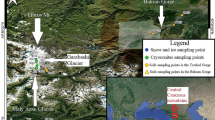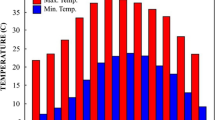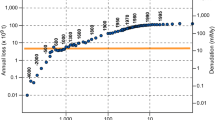Abstract
The caesium-137 profiles obtained in many investigations which have attempted to use caesium-137 measurements as a means of assessing the rate of accumulation of recent lake sediments, have not conformed to the classic shape expected from the record of fallout input. Such deviations have been accounted for in terms of post-depositional mobility of the caesium-137 input (e.g. bioturbation) and delayed inputs from the drainage basin. There have, however, been few attempts to determine the likely character of the drainage basin input and to analyse the role of such inputs in influencing the precise form of the caesium-137 profile. This paper presents the results of an attempt to employ existing knowledge concerning the behaviour of caesium-137 in soils and the processes of sediment mobilization to predict the likely form of the record of caesium-137 input to a lake or river floodplain from its drainage basin. The influence of this input on the profile shape will depend on the relative importance of the atmospheric fallout to the lake or floodplain surface and the drainage basin input to the total caesium-137 inventory in the sediment core, and on the land use and sediment sources in the drainage basin. By incorporating the drainage basin input into a simple model of caesium-137 accumulation in lake and floodplain sediments, it was possible to account for the profile shapes measured in four cores investigated by the authors and therefore to verify their utility for assessing rates of sediment accumulation.
Similar content being viewed by others
References
Bachhuber, H., K. Bunzl & W. Schimmack, 1982. The migration of 137Cs and 90Sr in multilayered soils: results from batch, column, and fallout investigations. Nuclear Technol. 59: 291–301.
Brunskill, G. J., S. D. Ludlam & T.-H. Peng, 1984. Fayetteville Green Lake, N.Y., U.S.A. VIII. Mass balance for 137Cs in water, varved and non-varved sediment. Chem. Geol. 44: 101–117.
Cambray, R. S., K. Playford & G. N. J. Lewis, 1982. Radioactive fallout in air and rain: results to end of 1981. Report no. AERE-R 10485, UK Atomic Energy Authority, Harwell, 43 pp.
Crank, J., 1975. The Mathematics of Diffusion. 2nd Edition, Clarendon Press, Oxford.
Davis, R. B., C. T. Hess, S. A. Norton, D. W. Hanson, K. D. Hoogland & D. S. Anderson, 1984. 137Cs and 210Pb dating of sediments from soft-water lakes in New England (U.S.A.) and Scandinavia, a failure of 137Cs dating. Chem. Geol. 44: 151–185.
Delaune, R. D., W. H. Patrick & R. J. Buresh, 1978. Sedimentation rates determined by 137Cs dating in a rapidly accreting salt marsh. Nature 275: 532–533.
Dominik, J., D. Burrus & J. P. Vernet, 1987. Transport of the environmental radionuclides in an alpine watershed. Earth planet. Sci. Lett. 84: 165–180.
Krey, P. W., E. P. Hardy & M. Heit, 1980. Nevada testsite fallout in the area of Enterprise, Utah. Environmental Measurements Laboratory, Department of Energy, New York, 30 pp.
Krishnaswami, S. & D. Lal, 1978. Radionuclide limnochronology. In A. Lerman (ed.), Lakes: Chemistry, Geology, Physics. Springer-Verlag, New York.
Livens, F. R. & D. L. Rimmer, 1988. Physico-chemical controls on artificial radionuclides in soil. Soil Use Mngt. 4: 63–69.
Livingstone, D. L. & R. S. Cambray, 1978. Confirmation of 137Cs dating by algal stratigraphy in Rostherne Mere. Nature 276: 259–261.
McCall, P. L., J. A. Robbins & G. Matisoff, 1984. 137CS and 210Pb transport and geochronologies in urbanised reservoirs with rapidly increasing sedimentation rates. Chem. Geol. 44: 33–65.
Menzel, R. G., 1974. Land surface erosion and rainfall as sources of strontium-90 in streams. J. envir. Qual. 3: 219–223.
Miller, K. M. & M. Heit, 1986. A time resolution methodology for assessing the quality of lake sediment cores that are dated by 137Cs. Limnol. Oceanogr. 31: 1292–1300.
Oldfield, F., 1981. Peats and lake sediments: formation, stratigraphy, description and nomenclature. In: A. Goudie (ed.), Geomorphological Techniques, George Allen and Unwin, London.
Olsen, C. R., H. J. Simpson, T.-H. Peng, R. F. Bopp & R. M. Trier, 1981. Sediment mixing and accumulation rate effects on radionuclide depth profiles in Hudson Estuary sediments. J. geophys. Res. 86: 11020–11028.
Payne, B. R., 1985. Measurement of rates of accumulation of sediments from radioisotope data. In Methods of computing sedimentation in lakes and reservoirs. UNESCO Technical Report in Hydrology, UNESCO, Paris: 219–224.
Ritchie, J. C., J. R. McHenry & A. C. Gill, 1973. Dating recent reservoir sediments. Limnol. Oceanogr. 18: 254–263.
Robbins, J. A., 1984. Coupled lakes model for estimating the long-term response of the Great Lakes to time-dependent loadings of particle-associated contaminants. U.S. National Oceanic and Atmospheric Administration, Ann Arbor, Michigan, 20 pp.
Robbins, J. A. & D. N. Edgington, 1975. Determination of recent sedimentation rates in Lake Michigan using Pb-210 and Cs-137. Geochem. Cosmochim. Acta 39: 285–304.
Robbins, J. A., J. R. Krezoski & SD. C. Mozley, 1977. Radioactivity in sediments of the Great Lakes: Post-depositional redistribution by deposit feeding organisms. Earth planet. Sci. Lett. 36: 325–333.
Sholkovitz, E. R. & D. R. Mann, 1984. The porewater chemistry 239,240Pu and 137CS in sediments of Buzzards Bay, Massachusetts. Geochim. Cosmochim. Acta 48: 1107–1114.
Smith, J. N. & K. M. Ellis, 1982. Transport mechanism for Pb-210, Cs-137 and Pu fallout radionuclides through fluvial marine systems. Geochim. Cosmochim. Acta 46: 941–954.
Smith, J. N., K. M. Ellis & D. M. Nelson, 1987. Time-dependent modeling of fallout radionuclide transport in a drainage basin: significance of ‘slow’ erosional and ‘fast’ hydrological components. Chem. Geol. 63: 157–180.
Walling, D. E. & S. B. Bradley, 1989. Rates and patterns of contemporary floodplain sedimentation: a case study of the River Culm, Devon, UK. Geojournal 19: 53–62.
Walling, D. E. & S. B. Bradley, 1990. Some applications of caesium-137 measurements in the study of fluvial erosion, transport and deposition. In Erosion, transport and depositional processes, International Association of Hydrological Sciences Publication no. 189: 179–203.
Walling, D. E. & P. W. Moorehead, 1989. The particle size characteristics of fluvial suspended sediment: an overview. Hydrobiologia 176/177: 125–149.
Wise, S. M., 1980. Caesium-137 and lead-210: A review of the techniques and some applications in geomorphology. In R. A. Cullingford, D. A. Davidson & J. Lewin (eds) Timescales in Geomorphology. J. Wiley & Sons, Chichester: 109–127.
Author information
Authors and Affiliations
Rights and permissions
About this article
Cite this article
Walling, D.E., Qingping, H. Interpretation of caesium-137 profiles in lacustrine and other sediments: the role of catchment-derived inputs. Hydrobiologia 235, 219–230 (1992). https://doi.org/10.1007/BF00026214
Issue Date:
DOI: https://doi.org/10.1007/BF00026214




